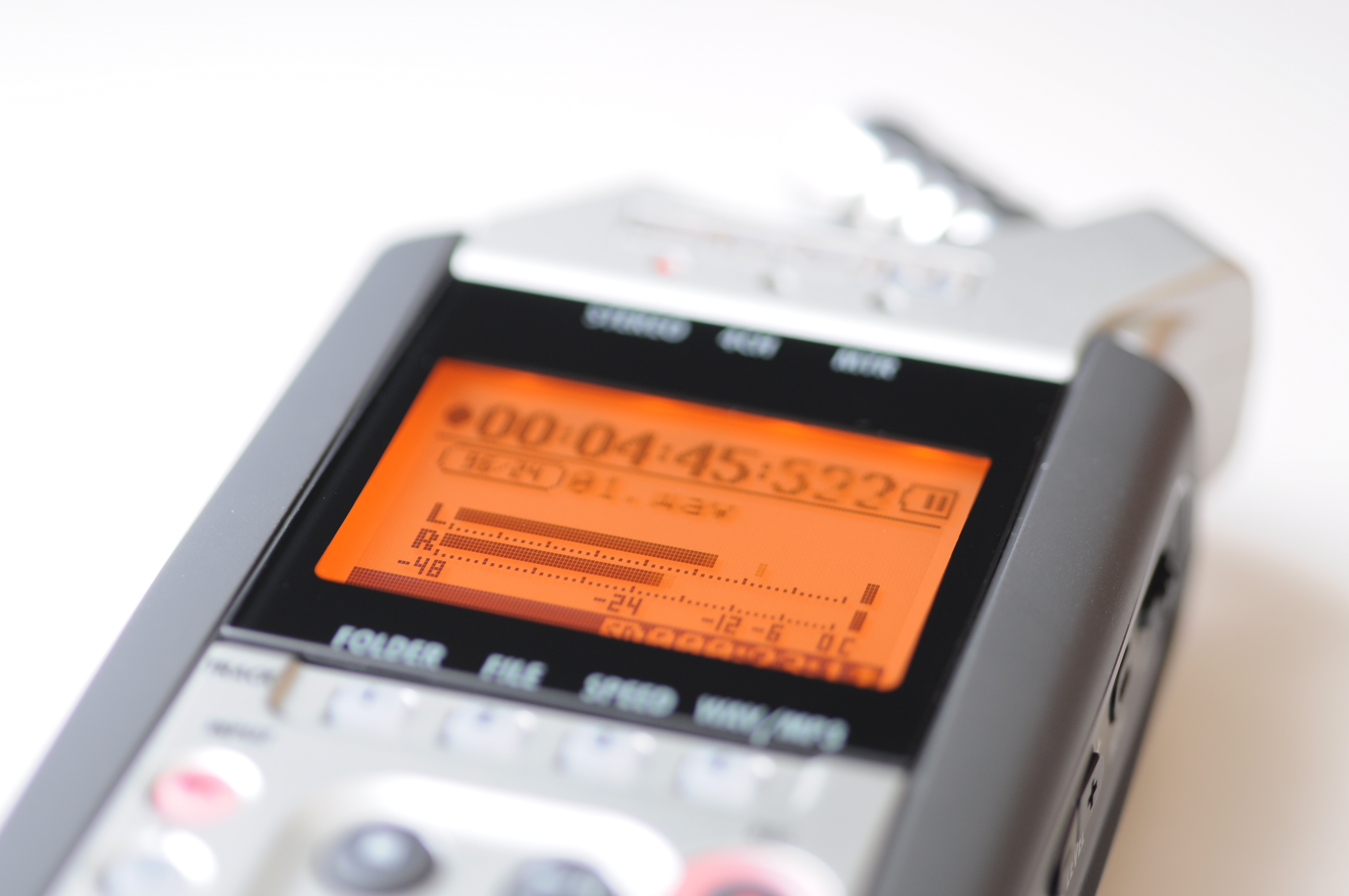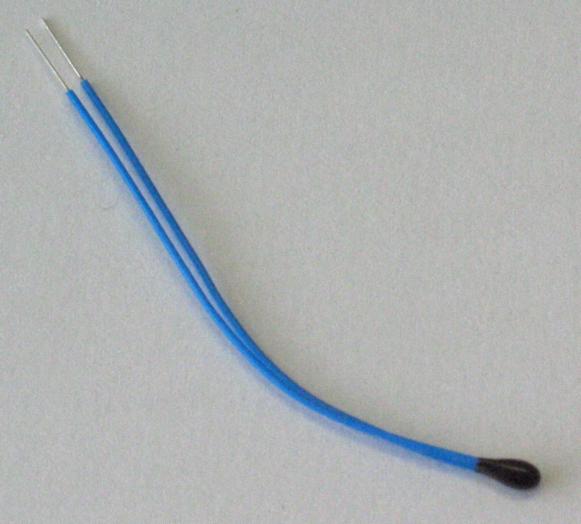|
Recording Thermometer
A recording thermometer is a type of thermometer that records temperature changes over a period of time. A digital recording thermometer is often called a temperature data logger. Analog temperature recorders A type of chart recorder, one end of a bi-metallic strip is attached to a long, light metal lever that holds a special pen. Tiny movements of the bimetallic strip cause much larger movements of the free end of the lever and the pen. The pen traces a rising and falling line on a strip of paper attached to a slowly turning drum. The drum usually makes one turn every seven or so days, so afterward each strip of paper contains a complete and accurate record of temperature changes for a whole week. The bimetallic strip is usually made from steel and copper. Because these metals expand and contract at different rates. When one of these metals expand it curls tighter, when one contracts it uncurls slightly. When it curls or uncurls, the data is converted into electric signals, which ... [...More Info...] [...Related Items...] OR: [Wikipedia] [Google] [Baidu] |
Thermometer
A thermometer is a device that measures temperature (the hotness or coldness of an object) or temperature gradient (the rates of change of temperature in space). A thermometer has two important elements: (1) a temperature sensor (e.g. the bulb of a mercury-in-glass thermometer or the pyrometric sensor in an infrared thermometer) in which some change occurs with a change in temperature; and (2) some means of converting this change into a numerical value (e.g. the visible scale that is marked on a mercury-in-glass thermometer or the digital readout on an infrared model). Thermometers are widely used in technology and industry to monitor processes, in meteorology, in medicine (''medical thermometer''), and in scientific research. A standard scale While an individual thermometer is able to measure degrees of hotness, the readings on two thermometers cannot be compared unless they conform to an agreed scale. Today there is an absolute thermodynamic temperature scale. Internat ... [...More Info...] [...Related Items...] OR: [Wikipedia] [Google] [Baidu] |
Temperature
Temperature is a physical quantity that quantitatively expresses the attribute of hotness or coldness. Temperature is measurement, measured with a thermometer. It reflects the average kinetic energy of the vibrating and colliding atoms making up a substance. Thermometers are calibrated in various temperature scales that historically have relied on various reference points and thermometric substances for definition. The most common scales are the Celsius scale with the unit symbol °C (formerly called ''centigrade''), the Fahrenheit scale (°F), and the Kelvin scale (K), with the third being used predominantly for scientific purposes. The kelvin is one of the seven base units in the International System of Units (SI). Absolute zero, i.e., zero kelvin or −273.15 °C, is the lowest point in the thermodynamic temperature scale. Experimentally, it can be approached very closely but not actually reached, as recognized in the third law of thermodynamics. It would be impossible ... [...More Info...] [...Related Items...] OR: [Wikipedia] [Google] [Baidu] |
Digital Recording
In digital recording, an audio signal, audio or video signal is converted into a stream of discrete numbers representing the changes over time in air pressure for audio, or Color, chroma and luminance values for video. This number stream is saved to a storage device. To play back a digital recording, the numbers are retrieved and converted back into their original analog signal, analog audio or video forms so that they can be heard or seen. In a properly matched analog-to-digital converter (ADC) and digital-to-analog converter (DAC) pair, the analog signal is accurately reconstructed, within the constraints of the Nyquist–Shannon sampling theorem, which dictates the sampling rate and quantization error dependent on the Audio bit depth, audio or Bit depth (computer graphics), video bit depth. Because the signal is stored digitally, assuming proper error detection and correction, the recording is not degraded by copying, storage or interference. Timeline *October 3, 1938: ... [...More Info...] [...Related Items...] OR: [Wikipedia] [Google] [Baidu] |
Chart Recorder
A chart recorder is an electromechanical device that records an electrical or mechanical input trend onto a piece of paper (the chart). Chart recorders may record several inputs using different color pens and may record onto strip charts or circular charts. Chart recorders may be entirely mechanical with clockwork mechanisms, electro-mechanical with an electrical clockwork mechanism for driving the chart (with mechanical or pressure inputs), or entirely electronic with no mechanical components at all (a virtual chart recorder). Chart recorders are built in three primary formats. Strip chart recorders have a long strip of paper that is ejected out of the recorder. Circular chart recorders have a rotating disc of paper that must be replaced more often, but are more compact and amenable to being enclosed behind glass. Roll chart recorders are similar to strip chart recorders except that the recorded data is stored on a round roll, and the unit is usually fully enclosed. Chart record ... [...More Info...] [...Related Items...] OR: [Wikipedia] [Google] [Baidu] |
Light Metal
A light metal is any metal of relatively low density. These may be pure elements, but more commonly are metallic alloys. Lithium and then potassium are the two lightest metallic elements. Magnesium, aluminium and titanium alloys are light metals of significant commercial importance. Their densities of 1.7, 2.7 and 4.5 g/cm3 range from 19 to 56% of the densities of other structural metals,Polmear I 2006, ''Light Alloys: From Traditional Alloys to Nanocrystals,'' 4th ed., Butterworth Heinemann, Oxford, , p. 1 such as iron (7.9) and copper (8.9). See also * Heavy metals upright=1.2, Crystals of lead.html" ;"title="osmium, a heavy metal nearly twice as dense as lead">osmium, a heavy metal nearly twice as dense as lead Heavy metals is a controversial and ambiguous term for metallic elements with relatively h ... * List of elements by density References {{DEFAULTSORT:Light Metal Sets of chemical elements Metals ... [...More Info...] [...Related Items...] OR: [Wikipedia] [Google] [Baidu] |
Thermocouple
A thermocouple, also known as a "thermoelectrical thermometer", is an electrical device consisting of two dissimilar electrical conductors forming an electrical junction. A thermocouple produces a temperature-dependent voltage as a result of the Seebeck effect, and this voltage can be interpreted to measure temperature. Thermocouples are widely used as list of temperature sensors, temperature sensors. Commercial thermocouples are inexpensive, interchangeable, are supplied with standard Electrical connector, connectors, and can measure a wide range of temperatures. In contrast to most other methods of temperature measurement, thermocouples are self-powered and require no external form of excitation. The main limitation with thermocouples is accuracy; system errors of less than one degree Celsius (°C) can be difficult to achieve. Thermocouples are widely used in science and industry. Applications include temperature measurement for kilns, gas turbine exhaust, diesel engines, and o ... [...More Info...] [...Related Items...] OR: [Wikipedia] [Google] [Baidu] |
Thermistor
A thermistor is a semiconductor type of resistor in which the resistance is strongly dependent on temperature. The word ''thermistor'' is a portmanteau of ''thermal'' and ''resistor''. The varying resistance with temperature allows these devices to be used as temperature sensors, or to control current as a function of temperature. Some thermistors have decreasing resistance with temperature, while other types have increasing resistance with temperature. This allows them to be used for limiting current to cold circuits, e.g. for inrush current protection, or for limiting current to hot circuits, e.g. to prevent thermal runaway. Thermistors are categorized based on their conduction models. ''Negative-temperature-coefficient'' (NTC) thermistors have ''less'' resistance at ''higher'' temperatures, while ''positive-temperature-coefficient'' (PTC) thermistors have ''more'' resistance at ''higher'' temperatures. NTC thermistors are widely used as inrush current limiters and temperature ... [...More Info...] [...Related Items...] OR: [Wikipedia] [Google] [Baidu] |
Data Logger
A data logger (also datalogger or data recorder) is an electronic device that records data over time or about location either with a built-in instrument or sensor or via external instruments and sensors. Increasingly, but not entirely, they are based on a digital processor (or computer), and called digital data loggers (DDL). They generally are small, battery-powered, portable, and equipped with a microprocessor, internal memory for data storage, and sensors. Some data loggers interface with a personal computer and use software to activate the data logger and view and analyze the collected data, while others have a local interface device (keypad, LCD) and can be used as a stand-alone device. Data loggers vary from general-purpose devices for various measurement applications to very specific devices for measuring in one environment or application type only. While it is common for general-purpose types to be programmable, many remain static machines with only a limited number o ... [...More Info...] [...Related Items...] OR: [Wikipedia] [Google] [Baidu] |




